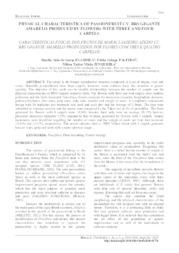Physical characteristics of passionfruit cv. Brs gigante amarelo produced by flowers with three and four carpels.
Physical characteristics of passionfruit cv. Brs gigante amarelo produced by flowers with three and four carpels.
Author(s): ESASHIKA, D. A. de S.; FALEIRO, F. G.; JUNQUEIRA, N. T. V.
Summary: ABSTRACT: The carpel is the female reproductive structure composed of a set of stigma, style and ovary. Normally passionflower have three carpels, however, some cultivars have this structure in greater quantity. The objective of this work was to identify relationships between the number of carpels and the physical characteristics of BRS Gigante Amarelo fruits. The flowers with three and four carpels were marked, pollinated and the fruits harvested from these flowers analyzed for transverse diameter, longitudinal diameter, pericarp thickness, fruit mass, pulp mass, pulp ratio, number and weight of seeds. A completely randomized design with 10 replicates per treatment was used and each plot had the average of 3 fruits. The data were submitted to variance analysis and the means were compared by the Tukey test at 5% of probability. The fruits generated by flowers with 4 carpels were 18,30% heavier, their pulp were on average 20.75% heavier, presented transverse diameter 7,53% superior to that of fruits generated by flowers with 3 carpels. Similar increments were identified regarding the number of seeds and the weight of seeds per fruit that increased 18,85% and 52.42%, respectively. This result indicates that cv. BRS Yellow Giant with 4 carpels generates heavier fruits, pulp and seeds with a more spherical shape.
Publication year: 2020
Types of publication: Journal article
Unit: Embrapa Cerrados
Keywords: Fruto, Maracujá, Morfologia Vegetal
Observation
Some of Embrapa's publications are published as ePub files. To read them, use or download one of the following free software options to your computer or mobile device. Android: Google Play Books; IOS: iBooks; Windows and Linux: Calibre.
Access other publications
Access the Agricultural Research Database (BDPA) to consult Embrapa's full library collection and records.
Visit Embrapa Bookstore to purchase books and other publications sold by Embrapa.

